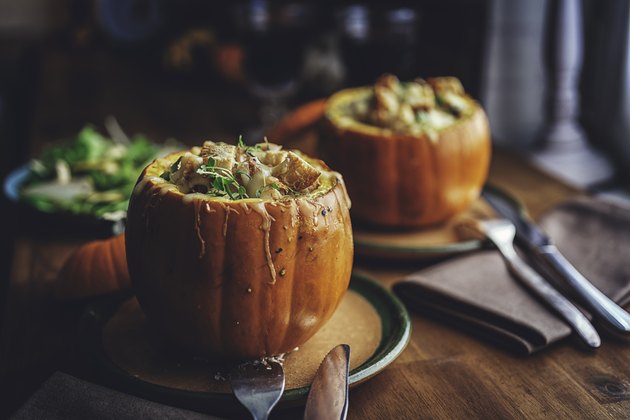Fall is associated with dying leaves, pumpkin spice lattes and chilly temperatures, but it also means positive change: Loved ones draw closer, a new school year begins, leaves turn vibrant colors and your cozy sweaters come out of hiding.

Sponsored Links
Fall months can bring warmth and brightness to your diet and overall wellness — if you approach them properly.
There are two main contributing factors to holiday season weight gain: increased hunger and reduced physical activity.
Fall Back Without Gaining Weight
As though rebelling against their upcoming New Year's healthy lifestyle and weight-loss resolutions, Americans consume more food and exercise less during the fall and early winter months than the rest of the year.
Gone are the months of sun and beach time, and the feast-filled holiday season begins. Depending on where you live, you may leave for work and return home in darkness, which is more likely to inspire curling up in front of the TV than going for a walk or a run. All of these factors can influence your diet.
"Summer is a time of cool salads, grilling, fresh fruit, cold drinks," says Diane Kress, a registered dietitian and author of The Metabolism Miracle. "It’s almost as if people begin to hibernate and seek comfort foods during the fall — casseroles, creamy sauces and rich desserts."
And if you're a parent of school-age children, you may rely on fast food, frozen meals and processed snacks, like potato chips, cookies and pretzels, for convenience as they race between the classroom, extra-curricular activities, study and rest time. But many of these foods are dense in unhealthy fats, sodium, refined grains and calories.
"On occasion, a quick meal is fine," says Kress, "but when it becomes the rule rather than the exception, nutrition is sacrificed."
Fall also kicks off the highest calorie months of the year. Football games, Halloween and Thanksgiving are paths to sugary, salty and high-fat snack foods, which are calorie-dense and nutrient-poor. In 2009, Americans spent $7.1 billion on potato chips, according to the National Academies of Sciences, Engineering and Medicine, much of which were consumed during fall months.
In a 2000 study conducted by the National Institute of Child Health and Human Development and the National Institute of Diabetes and Digestive and Kidney Diseases, researchers looked at the weight and overall health of 195 men and women over the course of six months. On average, each persona gained 1.05 pounds between Thanksgiving and New Year's Day.
While one gained pound may seem insignificant, holiday pounds tend to stay, say the researchers, and increase your risk for serious conditions, such as high blood pressure, heart disease and diabetes. By starting your fall season off on a healthy foot (or plate), you improve your chance of dodging these risks. Doing so can also reduce emotional risks associated with overeating and weight gain, such as depressive moods, anxiety and intense sensations of shame.

Healthy Eating Lessons From History
"We should be adopting almost all of the Native American and pilgrim eating principles," Kress says. "Lean meats in the form of naturally-fed game, poultry and fresh-caught fish from pure streams and a clean ocean. Fresh fruits and vegetables. [There were] no bleached, enriched white flours or pastas, no fast-food joints, convenience stores or junk food. Those were the days."
While it isn't necessary, or perhaps realistic, to limit your fall foods to fresh-picked, organic fare, cutting back on processed foods and eating more natural, seasonal options adds ample bang to your nutritional buck.
The NICHHD and NIDDKD study of 2000 revealed only two contributing factors to holiday season weight gain: increased hunger and reduced physical activity. Following early Americans' lead by eating more grains, nuts, seeds, fruits and vegetables adds plentiful amounts of vitamins, minerals, antioxidants, healthy fats and fiber to your diet.
Because fiber promotes satiation, you'll experience less hunger between meals. Whole foods typically also require more chewing, which slows your eating pace and promotes portion and appetite control. And emphasizing nutritious food guards against food cravings, which can stem from nutrient deficiencies.
Carolyn Scott-Hamilton, a holistic nutritionist, natural-foods chef and creator of the Healthy Voyager brand, recommends pumpkins, sweet potatoes and yams as prime fall-friendly food choices.
"While folks tend to eat them at holiday meals or as fried snacks, such as sweet potato fries or chips, these veggies are incredibly versatile and should be incorporated regularly in fall meals in order to take advantage of their seasonal health benefits," Scott-Hamilton says. So make like the pilgrims and Native Americans and eat vegetables fresh or cooked from plates, not packages.
Sponsored Links

Fabulous Fall Foods to Try
Eating in-season foods, or foods at peak harvesting time, provides another way of improving your diet during the fall. Not only are these foods at their nutrient prime, they also haven't been sitting on trucks or store shelves for months.
"One of the main benefits of eating seasonal foods is freshness," says Mark Thompson, who as the publisher of SeasonalChef.com visits and reports on farmers markets throughout the country.
"Also, though it might sound kind of corny to some, you really do start finding yourself getting in touch with the seasons when you get in the habit of eating locally grown, seasonal fruits and vegetables, and over the course of several years, begin to look forward to the arrival of seasonal favorites."
For best results, Thompson suggests shopping at farmers markets. "You can find any out-of-season item you want in the supermarket, but you can be sure it was grown on the other side of the world," he says.
At your supermarket, look for on-sale, colorful fruits and vegetables. Because of their plentiful supply, seasonal foods cost less. Although seasonal foods vary somewhat by region, fruits and vegetables particularly lush during autumn include:
ApplesWinter squashPumpkinBroccoliCauliflowerBeetsParsnipsChardEggplantsBell peppersRutabagasApricotsPearsGrapesApplesTo make use of fall produce, Thompson gives the following ideas:
Pureed squash for soupBaked cubed apples and butternut squash tossed in maple syrupSliced, lightly batter-fried Japanese kabocha squashRaw kale chipsBaked potato wedgesWhole grain pita chips with salsa or black bean dipApple and pear slices topped with almond butterGrilled portobello mushrooms.“There are so many fabulous treats to tailgate with," says Scott-Hamilton. "Try portobello mushroom sliders instead of burgers... or bake corn tortillas for homemade chips." For fizzy drinks minus the added sugars and calories in soda, combine seltzer water with pure fruit juice.
To trim unhealthy fat, cholesterol and calories from fall foods, Kress recommends baking, broiling and roasting lean meats and fish, then removing visible fat and skin before eating. When it comes to vegetables, aim for at least one fresh salad helping per day and steam other vegetables to retain nutrients. For a heart-healthy salad dressing, Kress suggested balsamic vinegar and olive oil. Hot green tea provides warmth, comfort and immune system-enhancing antioxidants.
Your most important beverage? "Water, water, water. Did I mention water?" Kress says. Staying well hydrated can help stave off excess hunger, which is often confused with thirst.
Rather than diet your way through the season, aim for balanced meals and snacks at regular intervals throughout each day. And regardless of your food choice, don't forget to count your blessings.
“Gratitude plays a major role in our general health any time of year," says Scott-Hamilton. "Positive thinking and being grateful for what you have instead of what you don't can have an amazing effect on your health. When you are consciously grateful, you are more likely to want to make smart choices for the health of your family and yourself.”

Sponsored Links
Winter Squash Risotto Recipe
INGREDIENTS
2 cups broth 3 cups water 2 tbsp. olive oil 1/4 cup finely chopped onion 3 cups diced butternut or other winter squash 1 cup Arborio rice 1/2 cup dry white wine 1/4 cup pine nuts 1/4 cup freshly grated Parmesan cheese Salt and freshly ground black pepper, to tasteDIRECTIONS
Simmer one cup of the diced squash in a saucepan with one cup water for 10 minutes, puree in a blender, and return to the saucepan. Add broth and remaining two cups of water, and bring to a slow simmer.Heat the olive oil in a heavy saucepan over medium-high heat. Add the onion and cook until translucent, about five minutes. Add the two remaining cups of diced squash and cook over medium heat, stirring frequently, until lightly browned, 10 to 15 minutes. Add the rice and pine nuts, and cook one minute, stirring constantly with a wooden spatula or spoon.
Add the wine and cook and stir until the liquid has evaporated. Add 1/2 cup of the broth mixture and cook, stirring constantly, until the liquid is absorbed. Continue stirring in the liquid, 1/2 cup at a time, until all or most of the liquid has been absorbed and the rice is tender but still al dente, 20 to 25 minutes.
Stir in 2 tablespoons Parmesan. Season with salt and pepper. Sprinkle the remaining Parmesan on top and serve.
Stay on Track This Fall With MyPlate
Get a handle on how many calories you're consuming each day (and how many you really need) by tracking your food using a free calorie tracker like LIVESTRONG.COM's MyPlate.
It'll also show you how many calories you are burning from exercise. You can even download the free mobile apps for iPhone and Android.
